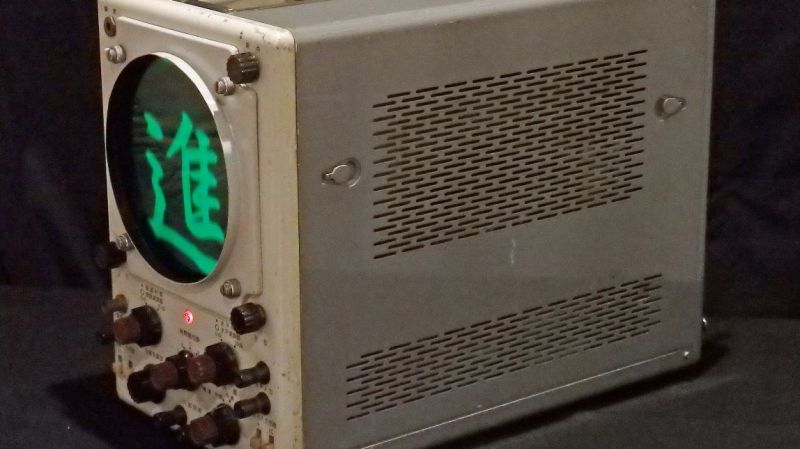Nostalgia aside, there are a few things an analog scope can still do better than a digital, with oscilloscope art being a prime example. The blue-green glow of phosphors in a real CRT just add something special to such builds, and as a practitioner of this craft, [Aaron] decided to paint a New Year’s affirmation on his oscilloscope screen, in Japanese calligraphy of all things.
When used in X-Y mode, analog oscilloscopes lend themselves nicely to vector-based graphics, which is the approach [Aaron] has taken with previous “Oscilloclock” builds, like the Metropolis Clock. The current work, however, doesn’t use vector graphics, opting instead to turn the scope into the business end of a VGA display. He had previously developed the hardware needed to convert a VGA signal into X- and Y-axis analog outputs, so the bulk of the work was rendering the calligraphy, first in ink and then scanning and processing the results into a file. In keeping with the Japanese theme, [Aaron] chose a rare scope from Nihon Tsushinki Co., Ltd., from 1963. It’s a beautiful piece of equipment and obviously lovingly restored, and with the VGA adapter temporarily connected, the four Japanese characters scroll gracefully up the screen, delivering the uplifting message: “Steady progress, day by day.”
[Aaron] sure puts a lot of work into his analog scope builds, which we’ve featured a few times. Check out the clock he made from Grandpa’s old Heathkit scope, or his Tektronic vectorscope clock. And don’t forget about other forms of oscilloscope art — they can make music too, after all.

















私に加わるか死ぬ。あなたはそれ以下をすることができますか?
Careful with that axe, Eugene.
それ以上できますよ。
だって、考えるので。考える物だから、居る。
お前はただの拙者の想像な物じゃないかい?
ご注意- 日本語文化、言語の専門者だ、俺。
Thanks for posting! Just a small correction – [Oscilloboy] is [Aaron]’s youngest son. There is also [Oscillokid], the eldest. Geeky family!
As someone who studied under an actual calligraphy master with his own school in Kobe as part of my degree, I appreciate the calligraphic aspect of this. I didn’t know oscilloscopes could do this.
Not only can they do this, but I’ve made a TV out of standard plug-ins for the Tektronix 7000 series bench scopes. First, a 4-slot mainframe, I think a 7704a, since that’s what I had on my bench at the time, then a 7L12 spectrum analyzer was used as the horizontal sweep generator and also RF tuner and detector (using the zero span setting), then a 7B85 for vertical sweep, then I think a 7A26 amplifier that was used to drive the Z (“blanking”) input. So not just VGA, but over-the-air broadcast TV, although this was in the analog TV days, and would be a lot more tricky today. Since I was a spectrum analyzer technician at the time, all of this was what was at my bench except the spectrum analyzer, but I always had a few of those in the repair/calibrate queue.
That is quite beautiful. If it were me doing this, I probably would have done something stupid like making a vector list drawing circuit, then doing a lot of processing of the scanned pictures to generate the filled vector list. This is a far simpler solution, even considering you need a computer to drive it – that’s what Raspberry Pi model A is for.